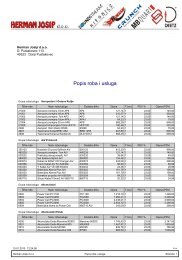and more often it is not possible to install radios ... - Herman Josip doo
and more often it is not possible to install radios ... - Herman Josip doo
and more often it is not possible to install radios ... - Herman Josip doo
Erfolgreiche ePaper selbst erstellen
Machen Sie aus Ihren PDF Publikationen ein blätterbares Flipbook mit unserer einzigartigen Google optimierten e-Paper Software.
Advice<br />
Power supply<br />
a) Power cable<br />
he power supply <strong>is</strong> the most important point concerning the <strong>install</strong>ation<br />
Tof a car-hifi-system.<br />
Using a sub-dimensioned power supply or wrong fuse values may <strong>not</strong> only<br />
cause a loss in performance but you even r<strong>is</strong>k that the car takes fire.<br />
In fact, the amplifier <strong>is</strong> able <strong>to</strong> transform only half of the current taken from<br />
the battery in<strong>to</strong> performance. The other half of the current <strong>is</strong> – depending<br />
on the construction – transformed in<strong>to</strong> heat. We call <strong>it</strong> the efficiency of an<br />
amplifier which ranges about 50 % in analogue types. Depending on the<br />
qual<strong>it</strong>y <strong>it</strong> can be <strong>more</strong> or less.<br />
The efficiency of a dig<strong>it</strong>al amplifier ranges about 75 %. Th<strong>is</strong> means that the<br />
loss in power <strong>is</strong> less.<br />
The following example explains how <strong>to</strong> choose<br />
the right cable cross-section:<br />
The <strong>to</strong>tal performance of an analogue amplifier <strong>is</strong> e. g. sinus 450 Watt<br />
at 4 Ohm stereo. The average voltage in the car ranges about 13,8<br />
Volt. You should consider the following calculation concerning the right<br />
choice of the cable cross-section.<br />
450 Watt/13,8 Volt = 32,61 Ampere/0, 5 (efficiency) = 65,22 Ampere<br />
A dig<strong>it</strong>al amplifier w<strong>it</strong>h identical performance would be calculated as<br />
follows:<br />
450 Watt/13,8 Volt = 32,61 Ampere/0,75 (efficiency) = 43,48 Ampere<br />
You can now gather the right cross-section from the table below.<br />
Supposing that a 20 qmm power cable has a res<strong>is</strong>tance of 8 Ohm<br />
w<strong>it</strong>hin the length of one meter. If we sum up the res<strong>is</strong>tances of a 5 m<br />
plus-cable <strong>and</strong> a 2 m minus-cable we get 5,6 m Ohm.<br />
Th<strong>is</strong> means for an analogue amplifier:<br />
65,22 Ampere x 0,0056 Ohm = 0,37 Volt<br />
The voltage <strong>is</strong> only 13,43 Volt. A new calculation would be the<br />
following:<br />
13,43 Volt x 65,22 Ampere x 0,5 (efficiency) = 438 Watt.<br />
Th<strong>is</strong> would in theory mean a loss in power of 12 Watt.The conductiv<strong>it</strong>y<br />
becomes worse if the temperature <strong>is</strong> r<strong>is</strong>ing. The most important fac<strong>to</strong>rs<br />
in th<strong>is</strong> case are the ambient temperature <strong>and</strong> the current intens<strong>it</strong>y.<br />
Transient res<strong>is</strong>tances occurring at terminals <strong>and</strong> fuses also influence<br />
the result negatively.<br />
Now consider the calculation of the dig<strong>it</strong>al amplifier.<br />
Cable cross-sections <strong>and</strong> length are the same.<br />
43,48 Ampere x 0,0056 Ohm = 0,24 Volt<br />
Remaining voltage: 13,56 Volt<br />
13,56 Volt x 43,48 Ampere x 0,75 (efficiency) = 442,2 Watt<br />
Loss in power: only 7,8 Watt.<br />
190<br />
The amplifier’s sw<strong>it</strong>ching power supply tries <strong>to</strong> compensate th<strong>is</strong> loss in<br />
power. The success <strong>is</strong> dependant on the qual<strong>it</strong>y of the amplifier. But <strong>it</strong><br />
will be surely the battery that will suffer <strong>and</strong> a usual battery can deliver<br />
high power only up <strong>to</strong> a certain point.<br />
The amplifier sooner or later <strong>is</strong> pushed <strong>to</strong> <strong>it</strong>s lim<strong>it</strong>s which means<br />
d<strong>is</strong><strong>to</strong>rtions <strong>and</strong> a worse sound. Sometimes even the loudspeakers<br />
may be destroyed. In th<strong>is</strong> case an amplifier may supply the<br />
loudspeaker outputs w<strong>it</strong>h direct current.<br />
Th<strong>is</strong> example makes clear that dig<strong>it</strong>al amplifiers are <strong>not</strong> only smaller,<br />
need less power <strong>and</strong> require in most cases a smaller cable cross<br />
section, they also do <strong>not</strong> stress the battery that strong which will<br />
therefore live longer. If the amplifiers have similar Watt indications<br />
the sound of the dig<strong>it</strong>al amplifier will be much cleaner in the threshold.<br />
Developing the cable belonging <strong>to</strong> the „Professional Line“ we intended<br />
after all <strong>to</strong> optim<strong>is</strong>e the internal res<strong>is</strong>tance of a cable. By a special<br />
treatment of the str<strong>and</strong>ed wire’s surface the internal res<strong>is</strong>tance was<br />
dec<strong>is</strong>ively reduced. If we connected for example a 20 sqmm<br />
Professional Line cable w<strong>it</strong>h a res<strong>is</strong>tance of 0,6 m Ohm/m <strong>to</strong> an<br />
analogue amplifier, the following results would be achieved.<br />
65.22 Ampere x 0,0042 Ohm = 0,27 Volt<br />
value of voltage 13,53 Volt<br />
13,53 Volt x 65,22 Ampere x 0,5 (efficiency) = 441,2 Watt<br />
Using a Professional Line cable the result would show a plus of<br />
3,2 Watt. Th<strong>is</strong> plus would be achieved w<strong>it</strong>hout manipulating the<br />
output stage. Using high qual<strong>it</strong>y cables, th<strong>is</strong> result can be transferred<br />
<strong>to</strong> all kinds of amplifiers.<br />
If the output stage has a low ohm charge <strong>and</strong>/or <strong>is</strong> working bridged,<br />
the increase of Watt-output has <strong>to</strong> be adapted <strong>to</strong> the cross-section<br />
of the cable.<br />
The right choice of the power cable<br />
151-200 A 20 35 50 70 95 95 120 120<br />
101-150 A 20 35 35 50 70 70 95 95<br />
81-100 A 10 20 35 35 50 50 50 70<br />
61- 80 A 6 20 20 20 35 35 50 50<br />
41- 60 A 6 10 20 20 35 35 35 35<br />
31-40 A 4 6 10 20 20 20 20 35<br />
21-30 A 4 6 10 10 20 20 20 20<br />
0-20 A 4 4 6 6 10 10 10 20<br />
2 m 3 m 4 m 5 m 6 m 7 m 8 m 9 m<br />
The calculation of the cable cross sections was made on the bas<strong>is</strong> that the<br />
maximal voltage drop over the length of the cable should <strong>not</strong> exceed 0,5<br />
Volt. The length indications are valid for the one-way length from the battery<br />
<strong>to</strong> the amplifier. The indicated cross sections refer <strong>to</strong> the go-<strong>and</strong>-return<br />
line (plus- <strong>and</strong> compound-impregnated conduc<strong>to</strong>r).



